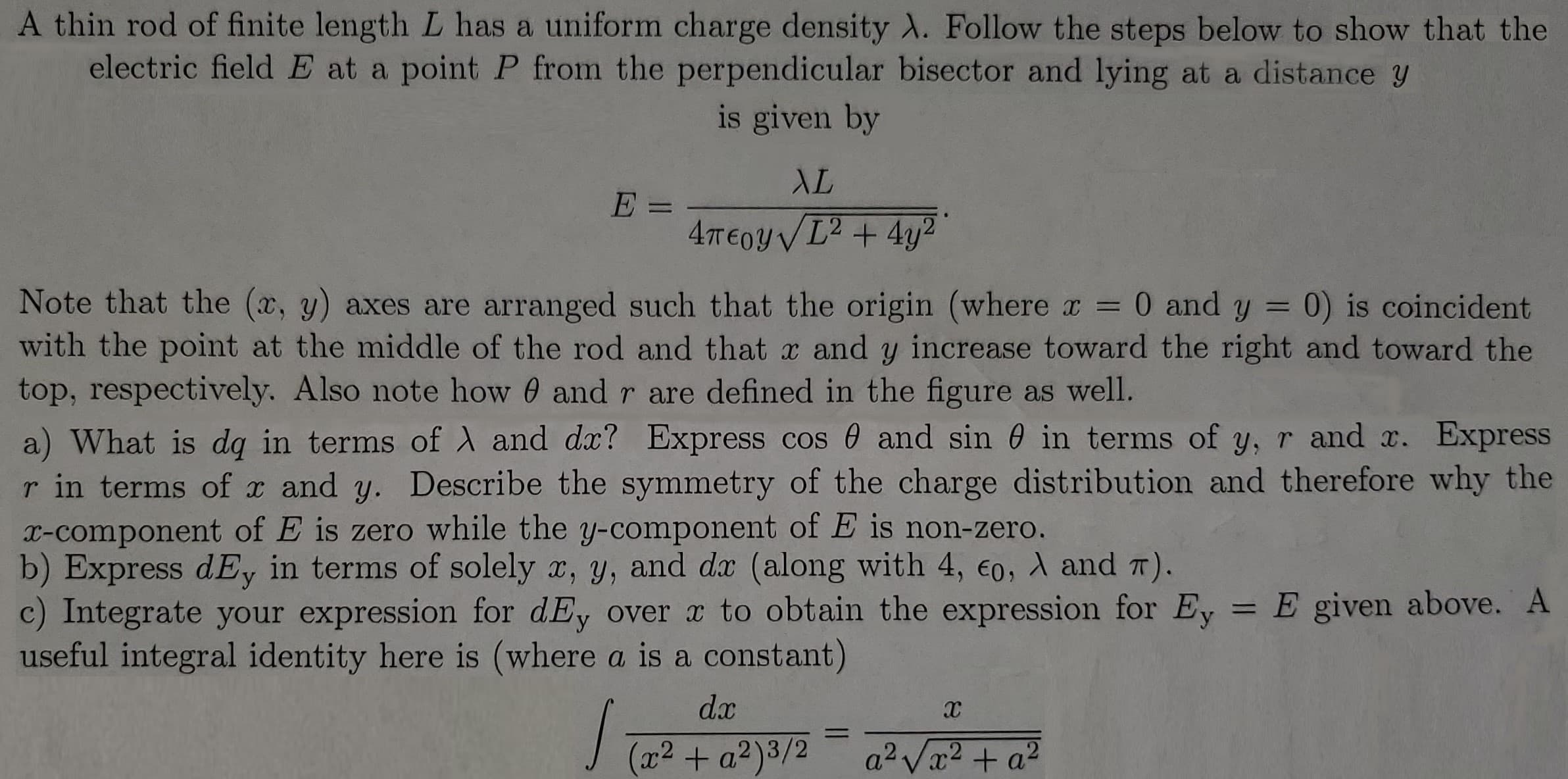A thin rod of finite length L has a uniform charge density X. Follow the steps below to show that th electric field E at a point P from the perpendicular bisector and lying at a distance y is given by AL E = %3D 4TE0YVI2 + 4y2 Note that the (x, y) axes are arranged such that the origin (where a = 0 and y = 0) is coincident vith the point at the middle of the rod and that x and y increase toward the right and toward the op, respectively. Also note how 0 and r are defined in the figure as well. a) What is dg in terms of ) and dx? Express cos 0 and sin 0 in terms of y, r and r. Expres - in terms of x and y. Describe the symmetry of the charge distribution and therefore why th C-component of E is zero while the y-component of E is non-zero. ) Express dEy in terms of solely x, y, and dx (along with 4, eo, A and T). - Integrate your expression for dE, over x to obtain the expression for Ey = E given above. %3D %3D
A thin rod of finite length L has a uniform charge density X. Follow the steps below to show that th electric field E at a point P from the perpendicular bisector and lying at a distance y is given by AL E = %3D 4TE0YVI2 + 4y2 Note that the (x, y) axes are arranged such that the origin (where a = 0 and y = 0) is coincident vith the point at the middle of the rod and that x and y increase toward the right and toward the op, respectively. Also note how 0 and r are defined in the figure as well. a) What is dg in terms of ) and dx? Express cos 0 and sin 0 in terms of y, r and r. Expres - in terms of x and y. Describe the symmetry of the charge distribution and therefore why th C-component of E is zero while the y-component of E is non-zero. ) Express dEy in terms of solely x, y, and dx (along with 4, eo, A and T). - Integrate your expression for dE, over x to obtain the expression for Ey = E given above. %3D %3D
Related questions
Question

Transcribed Image Text:A thin rod of finite length L has a uniform charge density X. Follow the steps below to show that th
electric field E at a point P from the perpendicular bisector and lying at a distance y
is given by
AL
E =
%3D
4TE0YVI2 + 4y2
Note that the (x, y) axes are arranged such that the origin (where a = 0 and y = 0) is coincident
vith the point at the middle of the rod and that x and y increase toward the right and toward the
op, respectively. Also note how 0 and r are defined in the figure as well.
a) What is dg in terms of ) and dx? Express cos 0 and sin 0 in terms of y, r and r. Expres
- in terms of x and y. Describe the symmetry of the charge distribution and therefore why th
C-component of E is zero while the y-component of E is non-zero.
) Express dEy in terms of solely x, y, and dx (along with 4, eo, A and T).
- Integrate your expression for dE, over x to obtain the expression for Ey = E given above.
%3D
%3D
Expert Solution
This question has been solved!
Explore an expertly crafted, step-by-step solution for a thorough understanding of key concepts.
Step by step
Solved in 8 steps with 7 images
